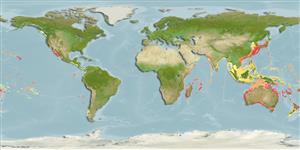>
Lampriformes (Velifers, tube-eyes and ribbonfishes) >
Veliferidae (Velifers)
Etymology: Metavelifer: Greek, meta = with, after + latin, vela = sail + Latin, fero = to carry (Ref. 45335).
More on author: Regan.
Environment: milieu / climate zone / depth range / distribution range
Ekologi
marina bentopelagisk; djupintervall 40 - 240 m (Ref. 9563). Temperate
Indo-Pacific: off Maputo in Mozambique; also from Australia, New Zealand and Hawaii. Reported from Japan (Ref. 559).
Size / Vikt / Age
Maturity: Lm ? range ? - ? cm
Max length : 28.0 cm TL hane/ej könsbestämd; (Ref. 6618)
Taggstrålar i ryggfenan (totalt) : 21 - 22; Mjukstrålar i ryggfenan (totalt) : 20 - 23; Taggstrålar i analfenan: 17 - 18; Mjukstrålar i analfenan: 16 - 18.
A benthic species (Ref. 75154) found on the continental shelf (Ref. 9563, 75154) and slope (Ref. 559); also on seamounts (Ref. 559).
Life cycle and mating behavior
Könsmognad | Reproduktion | Lek | Ägg | Fecundity | Larver
Heemstra, P.C., 1986. Veliferidae. p. 398-399. In M.M. Smith and P.C. Heemstra (eds.) Smiths' sea fishes. Springer-Verlag, Berlin. (Ref. 6618)
IUCN Red List Status (Ref. 130435: Version 2024-1)
Threat to humans
Harmless
Human uses
Verktyg
Special reports
Download XML
Internet-källor
Estimates based on models
Preferred temperature (Ref.
123201): 13.9 - 25, mean 17.6 °C (based on 189 cells).
Phylogenetic diversity index (Ref.
82804): PD
50 = 1.2500 [Uniqueness, from 0.5 = low to 2.0 = high].
Bayesian length-weight: a=0.01995 (0.00906 - 0.04395), b=3.01 (2.83 - 3.19), in cm total length, based on all LWR estimates for this body shape (Ref.
93245).
Trofisk nivå (Ref.
69278): 3.6 ±0.6 se; based on size and trophs of closest relatives
Fishing Vulnerability (Ref.
59153): Low vulnerability (18 of 100).
